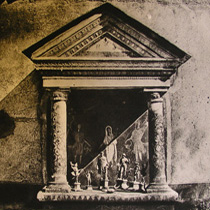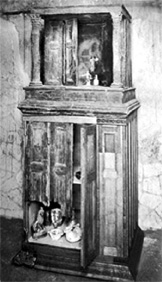 1
1Lararia situated in atria usually resembled miniature temples containing sculptural or pictorial references to guardian deities (fig.1). The deities provided the religious focal point for the dominus or domina (male and female heads of the family) and the household in general. Placing the main lararium in the atrium, along with ancestor cult imagery, not only sanctified the most public area within the house, but also communicated to all those who entered that it was protected by powerful spirits and benign ancestors. In some instances lararia, or their garden equivalents, were aligned with the entrance to the house, thus signifying its sanctified and protected status to all those who passed by (fig.2). The main front door to the house was left open during daylight hours, except in times of crisis. Aligning the lararium with the house entrance evoked a powerful relationship between the apotropaic imagery placed in the entrance and that associated with the entrance to the metaphysical world, the lararium, the miniaturised house within the house inhabited by guardian spirits.
The mise-en-abyme created by the juxtaposition of house and miniature spirit-house, in its turn, evoked the image of a sanctuary within a sanctuary. Hence, by making daily offerings, usually at meal-times, the occupants sanctified the house and themselves. (For more on this theme see Bettina Bergmann, The Roman House as Memory Theater: The House of the Tragic Poet in Pompeii, The Art Bulletin, Vol. 76, No. 2, p.225-56 1994) The presence of niche or painted lararia in working areas indicates that servants were also encouraged to invoke guardian spirits, thus ensuring well-being throughout the house (fig.3). The carbonised remains of portable wooden shrines, found in the upper floors of houses in Herculaneum, indicate that not all lararia were permanently sited (fig.4).
 1
1 4
4
|